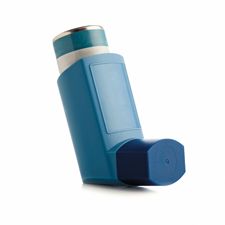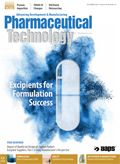Reverse Engineering a Pressurized Metered Dose Inhaler
Understanding the components of a reference marketed pMDI is needed to develop a generic pMDI.
Science Photo Library/getty images

Developing a generic equivalent to a current, marketed pressurized metered dose inhaler (pMDI) product can be challenging. Thorough analysis is crucial to gain a comprehensive understanding of the physical attributes and pharmaceutical performance of the reference marketed product. Many factors need to be assessed, understood, and combined to successfully develop a generic pMDI that will meet the regulatory and quality requirements as an equivalent product in the anticipated target market.
Significant information about the reference marketed product can be obtained from a thorough review of published literature, specifically the summary of product characteristics (SPC) and patient information leaflet (PIL). Additionally, baselining the reference marketed product for pharmaceutical performance offers a working target specification for in-vitro correlation that will ensure the smoothest possible path to commercialization and maximize return on investment. Baselining of the reference marketed product is also done to understand batch-to-batch variability and product performance over the stated shelf life to establish targets for critical quality attributes (CQAs), which can be applied to the generic equivalent pMDI.
The development of generic pMDIs must, therefore, use a total system approach to fully design and optimize new products to be safe, efficacious, robust, and reliable during patient use and over the product shelf life. To develop a generic equivalent, a number of elements are required to work together to ensure that the finished pMDIs operate appropriately and meet the appropriate regulatory and quality requirements. These sub-systems can be summarized as the input API, formulation composition, actuator, valve, canister, and secondary packaging.
Although significant information can be obtained from an in-vitro perspective, it is often the generation of in-vivo clinical data that is required to demonstrate equivalence between a new generic pMDI and the reference marketed product. In Europe, the orally inhaled product (OIP) guidelines describe a stepwise approach that should be employed to develop and gain registration of generic pMDI equivalents to current marketed products (1).
This article considers the various components of a reference marketed product that should be subject to reverse engineering. An understanding of these factors should be established in parallel to determining the pharmaceutical performance of the reference marketed product. The determination of the CQAs should include assessing the emitted dose of the product via dose content uniformity (DCU) or uniformity of delivered dose (UoDD) analysis depending on the target market. The aerodynamic particle size distribution (APSD) of the emitted dose should also be established using appropriate methodology--for example, Andersen cascade impactor (ACI) or next generation impactor (NGI). Analytical methodology for determining such factors should be appropriately developed and validated for this purpose. Testing regimens must be developed with consideration to both the marketed product and development products to ensure no bias in testing.
When selecting reference marketed products for reverse engineering, one should bear in mind that products supplied by the same manufacturer to different markets may not be identical. Some differing product attributes may be obvious, such as the presence of a dose counter or a particular secondary packaging, while others are subtler and are only discernable with close internal inspection. Product differences may also exist between different product strengths.
Formulation
Formulation composition. API concentration(s) should be discernible from the reference marketed product information. Additional excipients should be listed in the published SPCs; however, it is unlikely that the concentration of the excipients or the reason for their inclusion will be specified in the SPCs. Information on additional excipient concentrations may be present in patents, clinical literature, or other sources such as FDA’s Inactive Ingredients website. A thorough review of the patent landscape is advised, not only to ascertain if a direct copy is feasible but also to understand the intellectual property (IP) rights and freedom to practice surrounding the manufacture/processing of the API or the pMDI product.
Visual examination of the formulation will determine whether the reference marketed product is a solution or a suspension. It may offer insights into formulation composition and its suspension characteristics. Observing suspension behavior (e.g., the rate of creaming or sedimentation) may be useful for optimizing analytical methodology and developing patient usage instructions. Visualizing formulation suspension characteristics and deposition on the container closure system (CCS) may help to explain any trends in pharmaceutical performance data.
API particle size distribution (for suspension only). Identifying the particle size distribution (PSD) of the API in the reference marketed product enables selection of suitable input raw materials for feasibility studies. This assessment can be determined using appropriate laser diffraction particle sizing methodology. It should be noted, however, that although PSD determination is particularly beneficial for pMDIs containing a single API, it has limitations for a pMDI containing two or more APIs in suspension. For suspension products, selecting an API with a PSD close to that of the marketed product increases the likelihood of matching the in-vitro APSD.
Fill weight and number of actuations. Confirming fill weight and number of actuations per unit provides an indication of the required canister size and amount of formulation overage in the canister. Differences in fill weight or canister size between the reference marketed product and generic product may lead to variances in headspace, which can impact pharmaceutical performance.
Actuator
During reverse engineering, the reference marketed product actuator is evaluated for key parameters such as mouthpiece design, spray cone, exit orifice attributes, and expansion chamber geometry. These parameters should be incorporated into the design of the actuator for the new generic product if possible.
Actuator features and outer dimensions. Differences in actuator design and mouthpiece geometry will affect factors such as spray pattern, spray force, and deposition of API on the actuator. The following general attributes should be considered:
- Mouthpiece shape and actuator dimensions
- Presence of dust cap (tethered or loose)
- Materials of construction.
Other specific details to consider during the development of a generic equivalent product include the following.
Spacer compatibility. Testing with a spacer may be required during pharmaceutical/clinical testing. Ensuring that the generic product is compatible with the specified spacer will improve the probability of matching the reference marketed product from an in-vitro and in-vivo perspective.
Dose counter. Depending on the intended market, it is likely that some generic new pMDI products will require a dose counter or dose indicator (DC/DI). While it is unlikely that a direct copy of a dose counter will be possible, something functionally and visually similar should be developed to maintain patient recognition. The presence of a DC/DI (particularly integrated) may also affect the pharmaceutical performance of a product.
Spray orifice diameter (exit orifice diameter). The size of the spray orifice affects the APSD of the formulation and is, therefore, a critical parameter when trying to match a reference marketed product. Typical spray orifice diameters range from 0.3 to 0.6 mm and can be determined using microscopy.
Generally, the smaller the spray orifice diameter, the finer the spray, which leads to lower API throat deposition and a greater fine particle mass (FPM). However, this FPM may also lead to greater mouthpiece deposition and an increased risk of actuator occlusion.
The quality of the spray orifice finish is also important because a poor quality finish may affect the alignment of the spray, leading to increased API deposition on the actuator and an altered APSD profile.
Spray pattern and plume geometry. Spray pattern and plume geometry are important tests for assessing the performance of the actuator and can be affected by various factors including the size, shape, and design of the actuator; the size of the valve metering chamber and side pierce; canister vapor pressure; and formulation composition. The data from the reference marketed product provide a baseline for screening hardware and formulation options.
Spray force. The force of the emitted spray is closely related to throat deposition. Spray force measurement of the reference marketed product will provide a reference that should not be exceeded to ensure similar deposition profiles and patient perception of the new generic pMDI product. It has, therefore, been suggested that impaction force may provide a better way to evaluate in-vitro equivalence in support of new drug applications (NDAs) or abbreviated new drug applications (ANDAs) for orally inhaled drug products. The belief is that it is more closely related to patient sensation and aerosol deposition than the current parameters (2).
Container closure system
Valve. A clear understanding of the exact composition and functionality of the reference marketed product’s valve allows for selection of an appropriate valve for the generic pMDI product. Differences in the valve may affect factors such as formulation compatibility and pharmaceutical performance.
Many valve attributes of a reference marketed product need to be considered prior to generic product development, such as the metering volume, the manufacturer and the materials of construction, and any unusual features of the valve that may need to be understood.
Valve metering volume may be determined from information stated in the SPC or prescribing information. Confirming valve volume through laboratory testing enables selection of the correctly sized valve metering chamber to match the reference marketed product and highlights any differences between different product strengths.
Canister. Information on the canister and/or coating may be listed in the SPC or prescribing information. The presence of a coating on the canister may indicate deposition issues with the API or incompatibilities with the canister material. Identification of the coating is important if a direct match to the reference marketed product is required, otherwise, confirmation of coating presence may be adequate. The height and width of the canister will determine its physical compatibility with various actuators and dose counters.
Secondary packaging. Foil pouches and desiccant may affect product performance throughout the product’s shelf life. If foil pouches or a desiccant are present in the reference marketed product, they should be included in feasibility/development studies but they don’t necessarily have to match exactly. Attributes to be considered when analyzing secondary packaging include:
- Constitution of secondary packaging (e.g., carton, desiccant, foil overwrap, and PIL)
- Purpose of the secondary packaging, which can be determined through appropriate studies.
- If included, dimensions and composition of foil overwrap and quantity/type of desiccant.
Conclusion
As discussed in this article, the development of generic pMDIs is a technically challenging process that requires significant expertise. The growing market trend towards lower-cost generic products means that companies often need experienced partners to develop robust generic pMDI products that meet the requirements of the current regulatory landscape.
A comprehensive understanding of the physical attributes and pharmaceutical performance of the current reference marketed product through reverse engineering is a key step in the successful generic pMDI product development process because it will enable appropriate in-vitro test and reference product matching strategies to be adopted.
References
1. CPMP/EWP/4151/00 Rev. 1 (August 2009): CHMP Guideline on the Requirements for Clinical Documentation for Orally Inhaled Products (OIP) Including the Requirements for Demonstration of Therapeutic Equivalence Between Two Inhaled Products for use in the Treatment of Asthma and Chronic Obstructive Pulmonary Disease (COPD) in Adults and for use in the Treatment of Asthma in Children and Adolescents [OIP Guideline].
2. C Guo et al., Journal of Pharmaceutical Sciences, 98 (8) 2799-2806 (2009).
Article Details
Pharmaceutical Technology
Vol. 40, No. 10
Pages: 28–32
Citation
When referring to this article, please cite it as S. Dexter and A. Slowey, " Reverse Engineering a Pressurized Metered Dose Inhaler,” Pharmaceutical Technology 40 (10) 2016.

Drug Solutions Podcast: A Closer Look at mRNA in Oncology and Vaccines
April 30th 2024In this episode fo the Drug Solutions Podcast, etherna’s vice-president of Technology and Innovation, Stefaan De Koker, discusses the merits and challenges of using mRNA as the foundation for therapeutics in oncology as well as for vaccines.
INTERPHEX 2025: Use of Walk-In Chambers for Bio/Pharma Development and Manufacturing
April 2nd 2025Sitting down with the PharmTech Group at INTERPHEX 2025, Christopher Murphy, director of Global Business Development and Service Customer Support at Environmental Specialties, discusses the design and critical role of walk-in chambers in the bio/pharmaceutical industry.